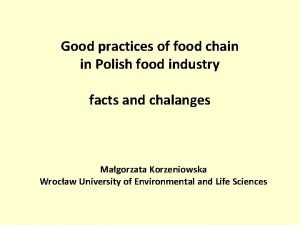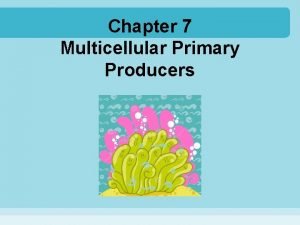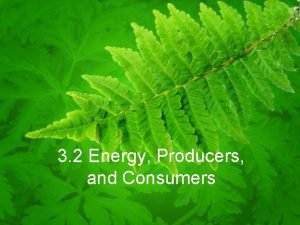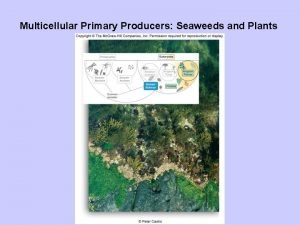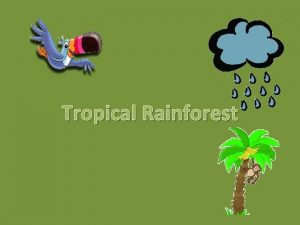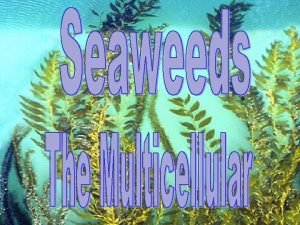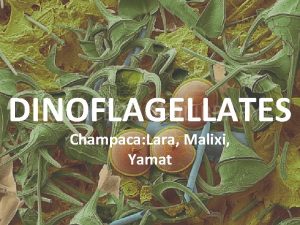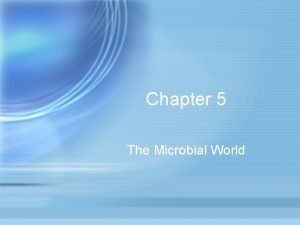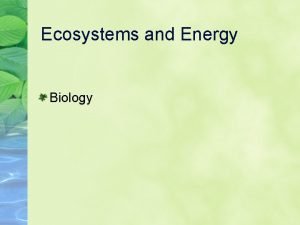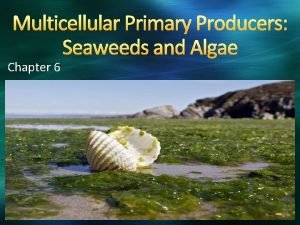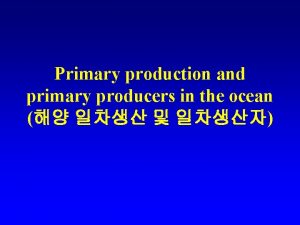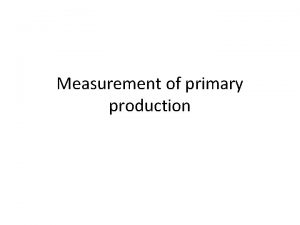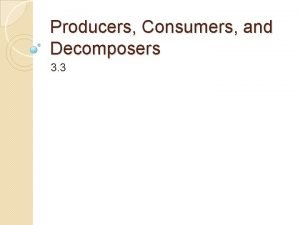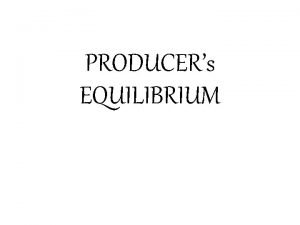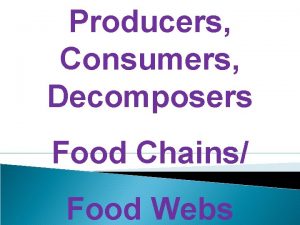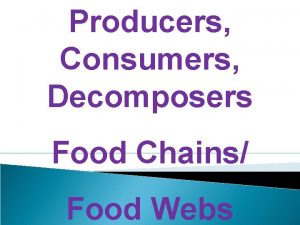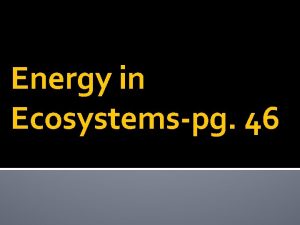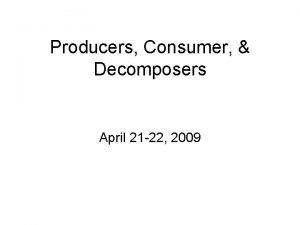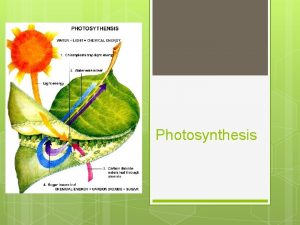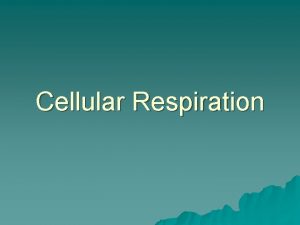PRIMARY PRODUCTION INTRODUCTION The primary producers are green
















- Slides: 16

PRIMARY PRODUCTION

INTRODUCTION �The primary producers are green plants which convert carbon dioxide and water into organic matter using sunlight as the energy source (photosynthesis). � In simplified form, the photosynthetic reaction is written as follows: � 6 CO 2 + 6 H 2 O + sunlight → C 6 H 12 O 6 (carbohydrate) + 6 O 2 �In this reaction, carbon dioxide and water vapour are converted to simple sugars and oxygen. �The energy required for metabolic activity is derived by reversing this reaction (respiration)

�There are several types of productivity. � Primary productivity is the conversion of inorganic compounds into organic compounds. �Gross primary productivity is the total amount of organic material synthesized during photosynthesis or chemosynthesis. �Net primary productivity is the difference between the gross productivity and the amount of organic material used during respiration. �Net productivity = Gross productivity - Respiration

Primary productivity can be determined in a number of ways. 1. Light and dark bottle technique �A water sample is collected from a particular depth in the ocean. The oxygen content of the water sample is measured. �The water from the sample is then placed in two bottles, one is transparent (light bottle) and the other is opaque (dark bottle). �The two bottles are submerged at the original depth of the water sample for a period of time.

�Both photosynthesis and respiration will occur in the light bottle while only respiration will occur in the dark bottle. �The bottles are then retrieved and the oxygen content of each bottle is measured. �Gross photosynthesis = increase in oxygen in light bottle + decrease in oxygen in dark bottle �Net photosynthesis = increase in oxygen in light bottle

2. 14 C method �A known amount of radioactive carbon in the form of bicarbonate is added to a water sample. � The uptake of carbon by the primary producers is determined by measuring their radioactivity. 3. Standing crop of phytoplankton � Phytoplankton are free-floating microscopic plants which are the primary producers of the oceanic system. �In this method, either the number of plankton or the total weight of plankton per unit volume or unit area is measured.

FACTORS INFLUENCING PRIMARY PRODUCTION 1. Light � One of the most obvious variable factors influencing primary production is the amount of solar energy reaching the surface of the sea. �The light that penetrates the water is rapidly absorbed by inorganic and dead organic matter present in it. �Thus, nearly 80% of the total solar radiation is absorbed in the upper 10 metres �only 1% of incident visible light reaches 120 meters in clear tropical waters and 10 to 20 meters in turbid inshore waters of the incident light that falls over the sea �only 0. 02 to 2. 0% or 0. 1% on an average alone is utilized for the production of organic matter.

�In the tropical regions of the earth, the sun is directly overhead at midday (or) virtually perpendicular to the sea surface, giving an angle for maximum penetration of light into the water column. � In the temperate regions, the sun may be directly overhead during the summer months, but may be far from this position at the other times of the year �In the polar regions, the sun is absent during the winter or is so low to the horizon that no light can penetrate the water. The presence of ice in these areas also reduces light penetration into the water.

�The portion of light that enter the water column is subject to further reduction from two additional processes acting on it within the water. �The first is reflection from various suspended particles in the water column. Suspended living or dead particles intercept the light and either absorb it (or) reflect it back to the surface. �Secondly, water itself absorbs light, making it unavailable for the plants � Sunlight spectrum includes all the visible colours ranging from violet to red or wavelengths from about 400 - 700 mm. �The green and blue components are absorbed less rapidly and hence penetrate most deeply.

�The rate of photosynthesis is high in high light levels and decreases as the light intensity decreases. �The rate of respiration of the phytoplankton cells is essentially constant at all depths. �At some point, the photosynthetic rate equals the respiration rate. At this point, there is net production of organic material and this depth is called Compensation depth �The compensation depth also changes with season, due to the change in the position of the sun and it may be absent during the winter months in high latitudes.

2. Temperature �Temperature acts along with other factors in influencing the variation of photosynthetic production. �The rate of photosynthesis increases with an increase in temperature but diminishes sharply after a point is reached. �Temperature has some important indirect effects on production, particularly in relation to its role in the establishment of a thermocline and also in the mixing of water, resulting in the supply of nutrients to the euphotic zone.

3. Salinity � Besides light and temperature, salinity also is known to influence primary production. �For example, Skeletonema shows an optimum rate of photosynthesis at salinities ranging from 15 and 20%, although the process could go on in a much wider range of 11 - 40 %. �Many species of dinoflagellates such as Ceratium, Peridinium and Prorocentrum reproduce actively at lower salinities.

4. Nutirents �The concentration of phosphates and nitrates, which are the two major plant nutrients �During photosynthesis phytoplankton absorb these nutrients for the formation of particulate organic matter �A certain amount of nutrients utilized by phytoplankton are however, regenerated by bacterial activity within the euphotic zone itself �Thus, much of the nutrients absorb from the euphotic layer are transferred to the deeper zones of the aquatic systems where they are regenerated. .

�The nutrients that accumulate in the deeper levels, particularly in the oceans, are mostly returned to the surface waters by vertical mixing process such as upwelling, eddy diffusion, vertical convection and wind mixing. �Seasonal and regional variations of primary production are often attributed to the influence of these plant nutrients. �The cycle of phytoplankton in temperate latitudes, with marked peak in spring and decrease in production during summer, has been correlated with the changes in nutrient levels �During winter, owing to vertical mixing, the euphotic zone is enriched with nutrients which result in high productivity during spring

�In summer, owing to the increase in temperature and the consequent formation of thermocline, the nutrient replenishment in the euphotic zone by vertical mixing is prevented and this results in the decrease of production. �In the tropical waters, a permanent thermocline is present throughout the year and consequently, replenishment of nutrients by normal mixing process does not take place. � Thus, short supply of nutrients in the tropical waters seems to impose a restriction on the rate of primary production.

Grazing by zooplankton �The grazing rate of herbivorous zooplankton, consisting mainly of copepod species, euphausids, pteropods, cladocerans, appendicularians, salps. �The inverse relationship in the distribution phytoplankton and zooplanktons is usually common, of �where phytoplankters are abundant, zooplankters are few and where zooplankters are abundant, phytoplankters are few � Hence, herbivorous zooplankton production to a greater extent. affects primary
 Insidan region jh
Insidan region jh Apa yang dimaksud dengan pre production process
Apa yang dimaksud dengan pre production process Green green green red
Green green green red Primary and secondary consumers
Primary and secondary consumers Primary producers definition
Primary producers definition Producers primary consumers secondary consumers
Producers primary consumers secondary consumers Multicellular producers
Multicellular producers Primary producers
Primary producers Food chain producer
Food chain producer Are algae producers
Are algae producers Tropical rainforest secondary consumers
Tropical rainforest secondary consumers Is seaweed a primary producer
Is seaweed a primary producer Primary producers in the ocean
Primary producers in the ocean Endophytes are primary producers that live
Endophytes are primary producers that live Primary producer biology
Primary producer biology Algae chapter
Algae chapter Lernpyramide von green & green (2005)
Lernpyramide von green & green (2005)




